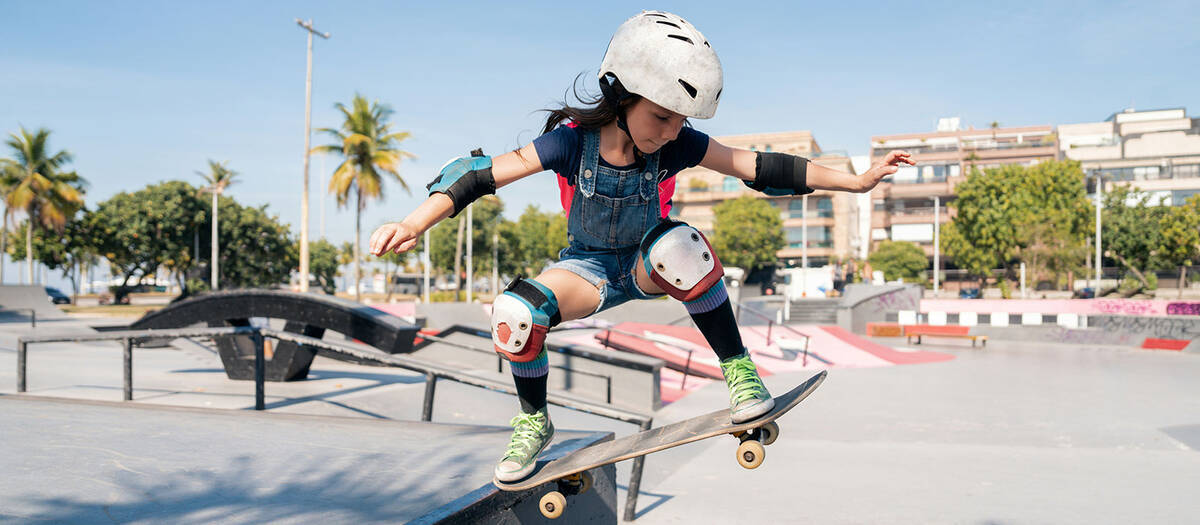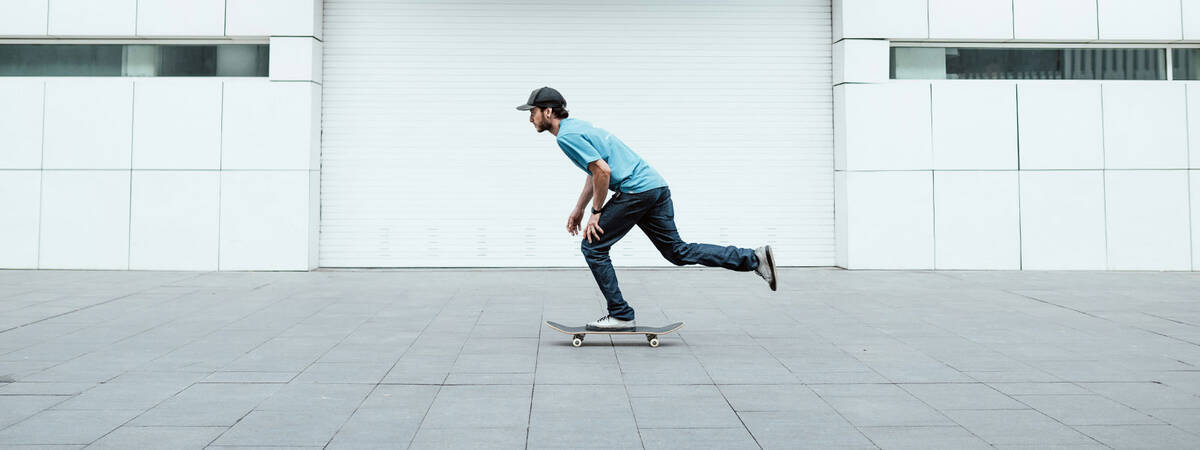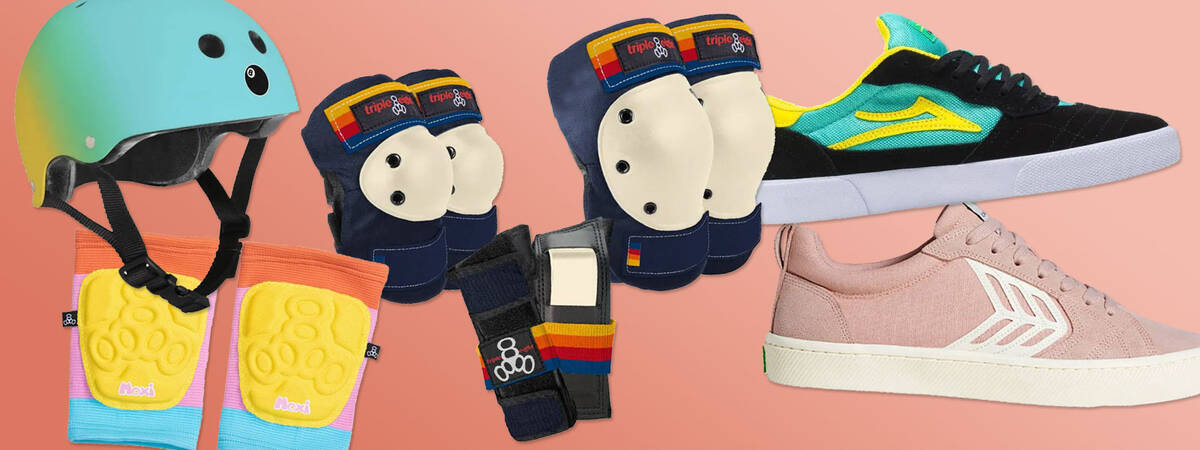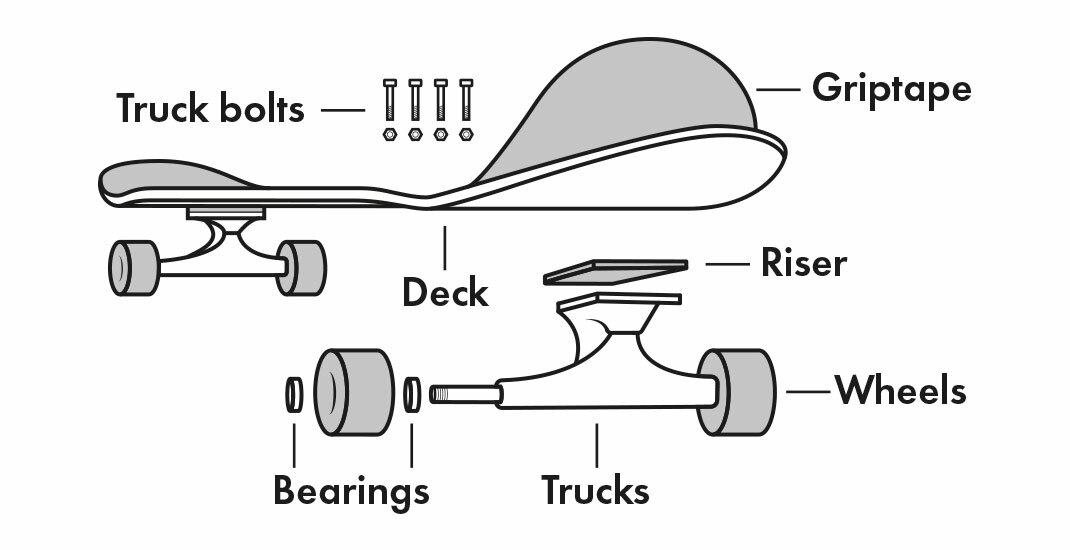How to Purchase a Skateboard – A Guide for Starters
It is advantageous to thoroughly assess the diverse options when picking a novice skateboard. The differences among skateboards are more than one might anticipate. This guide aims to illuminate the key considerations you might have, whether you're just starting or returning to the sport after a lengthy pause.
Overview
Various Beginner Skateboard Styles

When selecting your inaugural skateboard, it's essential to think about the skateboarding style you foresee enjoying most. As you advance, your preferences in skateboarding will become more apparent, allowing you to make more refined choices. As a starter, it’s advisable to choose a multi-purpose skateboard suited for learning basic tricks and moves. There's no necessity to make extremely specialised decisions at the start.
As a newcomer, your choice should be among these three primary types of skateboards:
- Skateboards: Designed for tricks, these are typically used in street and park settings. They possess concave decks with double kick tails and smaller wheels, making them an excellent stable base for novices to kick-start their skateboarding journey.
- Cruiser Skateboards: If skateboarding primarily for transit or leisure cruising appeals to you, a cruiser skateboard is a superb option. With broader decks and softer wheels, these boards ensure comfort and easy manoeuvrability, providing a smooth journey on uneven terrains. Should cruisers be your interest, peruse our Guide to Buying Cruiser Skateboards or explore our quality range of Cruiser Skateboards.
- Longboards: Ideal for newbies seeking stability and a gentle ride, longboards are a fantastic choice. Well-suited for commuting and downhill paths, they offer a relaxed and steady entrée to skateboarding. Longboarding offers varied disciplines such as longboard dancing, freestyle, or downhill. If this interests you, view our Guide to Buying Longboards or examine our array of Longboards.
This guide predominantly focuses on regular skateboards suitable for beginner skateboard tricks.
Which Skateboards Are Ideal for Kids & Teenagers Starting Out

Requests for beginner skateboards tailored for girls or stylish boards suited for boys are not uncommon. You have a plethora of options to satisfy the specific aesthetic tastes of the prospective rider.
At initial stages, a budget-friendly skateboard may suffice, but consider if the skateboard chosen should support further skill development as a skater.
Ultimately, any skateboarder will reach a stage where they are learning to pop ollies and perform tricks, at which point having a hard, responsive deck becomes beneficial for maximising performance. When acquiring a skateboard for someone at this juncture, it’s worthwhile contemplating a complete skateboard that falls within a moderately higher price bracket, though it’s not strictly necessary.
Pay attention to these specifications when selecting a complete skateboard for kids:
- Deck width: Choose a deck width roughly corresponding to the child's shoe length. A skateboard that's overly wide can make steering hard, while one that's too narrow might lessen stability. For further insights, refer to our Skateboard Size Guide or find more on this matter further along in this guide.
- Wheel hardness: A wheel hardness no greater than 92A is advised for beginners. Softer wheels are less likely to cause abrupt stops when rolling over small stones or cracks, reducing the chance of falls that might deter someone new to skateboarding.
- Bushings: For children weighing under 65 kg, go for a skateboard with bushings below 90A hardness. Truck bushing hardness dictates the amount of pressure a skater needs to apply to steer the skateboard effectively. Softer bushings (lower durometer) facilitate easier steering, while harder bushings (higher durometer) can pose more of a challenge.
When browsing our Complete Skateboards selection, you can filter boards by wheel hardness and deck length to see only those skateboards that meet your criteria.
Identifying Optimal Beginner Skateboards for Adults

With a suitably chosen complete beginner skateboard, adults can confidently start their skateboarding journey, regardless of prior experience or age. Whether you’re a complete beginner or returning to the skate scene after a break, you will find a pre-assembled complete skateboard that meets your needs. Make wise choices, especially since as an adult, your weight is likely more than a teenager’s.
When selecting a suitable complete skateboard for an adult novice, weigh these characteristics:
- Wood type: Opt for a 7-ply maple deck. It's advisable to avoid Chinese maple due to its tendency to be softer and less resilient, primarily because of the faster growth rates of Chinese maple trees. Maple sourced from colder regions tends to be more robust and dense, providing more pop and durability to skateboard decks.
- Adult skateboard size: When picking a beginner skateboard as an adult, aim for a deck width matching the length of your shoes. Choosing a deck broad enough to accommodate your feet will render steering easier. Sticking to our general recommendations (stated below) as a novice is sensible. However, as your skating skills progress, you might develop tastes that deviate from these recommendations.
- Wheel hardness: Opt for a wheel hardness below 97A. Harder wheels absorb fewer vibrations from uneven surfaces, while softer wheels offer less response and agility. Advanced skaters often lean towards ratings above 97A, though beginners generally fare better with softer wheels.
- Bushings: Truck bushing hardness impacts skateboard steering capability. Generally, heavier individuals will find harder bushings more suitable. For those weighing between 65 - 79 kg, bushings rated 85A to 95A are ideal, whereas 91A bushings or above are preferable for anyone weighing 80 kg or more.
Returning to Skateboarding as an Adult
You're never too old to skate! Even after a break, your experience isn’t lost. Fundamentally, the essence of skateboarding remains unchanged—a wooden deck, two trucks, and four wheels.
How can you resume skateboarding? Choose a skateboard that meets your needs and let your muscle memory guide you. Whether you aim to master the skatepark or tackle local street spots, select a skateboard that aligns with your goals.
Boards for those beyond youth often suit cruising more aptly, as many deem striving for hardcore skating unnecessary. If you're an adult getting back into skating, seek a wider deck and slightly softer wheels. To enable minor stunts, ensure the deck features kick tails at either end.
Experienced skaters rekindling their passion typically know about skateboards and parts, rendering the creation of a custom skateboard tailored to your requirements the ultimate choice. Explore our Custom Skateboard Builder or delve into our expansive selection of Skateboard Parts to handpick each component for your setup.
Selecting the Right Skateboard Size for Newcomers
By following our skateboard size chart, you can pinpoint an appropriate size for your initial skateboard. The primary focus with skateboard sizing revolves around deck width. Typically, your preferred deck width may alter over time. As you grow interested in specific skateboarding styles, you'll select a deck width that matches your new riding style more aptly. However, for beginners, we propose choosing skateboard size based on your shoe size.
If you are purchasing a first-time skateboard for a child, adhering to the size chart is a sensible choice.
| Skateboard Width | Recommended Age | Shoe size US | Shoe size UK | Shoe size EU |
| 6.5" | 3 - 5 | 6C - 11C | 5Y - 10Y | 23 - 28 |
| 6.75" | 3 - 5 | 7C - 11C | 6Y - 10Y | 24 - 28 |
| 6.825" | 4 - 6 | 9C - 12C | 8Y - 11Y | 26 - 30 |
| 7.0" | 5 - 7 | 10C - 1 | 9Y - 12Y | 28 - 32 |
| 7.125" | 6 - 8 | 11C - 2 | 10Y - 1 | 29 - 33 |
| 7.25" | 7 - 9 | 12C - 3 | 11Y - 2 | 30 - 34 |
| 7.375" | 8 - 10 | 13C - 4 | 12Y - 3 | 31 - 35 |
| 7.5" | 9 - 11 | 1 - 6 | 13Y - 5 | 32 - 38 |
| 7.625" | 10 - 12 | 2 - 7 | 1 - 6 | 33 - 39 |
| 7.75" | 12 - 14 | 4 - 9 | 3 - 8 | 35 - 42 |
| 7.875" | 12 - 14 | 4 - 9 | 3 - 8 | 35 - 42 |
| 8" & Up | 14 & Up | 9 & Up | 8 & Up | 42 & Up |
Guidance for Skateboarding Beginners

Mastering skateboarding fundamentals demands time and practice, yet the best guidance remains straightforward: persist! Enjoy yourself, adhere to your instincts, and before long, you’ll confidently explore the skatepark. Here’s some practical advice that might benefit you:
Essential Protective Gear for Beginners
Both novices and experts should skate with helmets and pads. Fear of falling can stymie progress, but high-quality wrist, knee, and elbow pads alongside a certified skate helmet can diminish this fear and boost performance. Stay secure and skate confidently with protective gear. This point is crucial for any beginner!
Explore our range of Skateboard Pad Sets and trustworthy Skateboard Helmets.
For the best helmets and protection gear for kids, see our collection of Skateboard Protection for Kids.
Footgear for Skateboarding
Investing in designated skate shoes from renowned skate shoe brands is worthwhile. While it’s possible to skate in any trainer, eventually, you will likely want to consider genuine skate shoes.
But what benefits come with opting for genuine skate shoes?
To start, they enhance your ability to skate: equipped with flat soles and advanced traction, they offer superior grip on the deck. Designed to optimise "board feel," the soles boost your sense of control over the board, leading to more responsive handling and greater command of the skateboard.
Additionally, skate shoes are crafted to withstand the wear and tear of skateboarding. Skateboarding can indeed be harsh on footwear. Quality skate shoes endure longer and last through numerous sessions compared to standard trainers.
Explore our range of Skate Shoes.
Attire for Skateboarding
For skateboarding, you require trousers that are both flexible and robust. As a newcomer, frequent falls are expected, affecting your trousers. Moreover, your trousers must not limit your range of motion. Trousers made from elastic materials and/or with a loose fit are advisable for skaters.
Provided your trousers do not restrict your movement and are crafted from durable material, they will be suitable for skateboarding. In fact, some of the most trendy skate trousers are work trousers. Browse our collection to choose your new dedicated Skate Trousers, and we also offer a splendid array of Skater Belts!
Adjusting the Truck
The handling of your skateboard can be modified by tightening or loosening the trucks. Ideally, your skateboard should follow the direction you lean towards while moving. Should it not do so, consider loosening the trucks slightly. On the other hand, if maintaining control is challenging due to excessive movement, the trucks should be tightened. Altering the kingpin nut can substantially influence your skateboard's riding dynamics!
As all skaters differ in weight and height, the pressure exerted on the trucks varies per individual. Because of this, there isn't a universally optimal truck tightness; thus, it's wise to experiment until you find the ideal balance that ensures stable and steady rolling.
View this instructional video to learn how to adjust your skateboard trucks, and keep in mind that a Skate Tool is an affordable, long-lasting purchase.
Components of a Skateboard – Dissecting the Skateboard

If you are truly committed to skateboarding, building your own custom skateboard is preferable. Even when buying a beginner complete, it’s beneficial to understand the fundamentals of skateboard components—commonly known as the anatomy of a skateboard.
There are strong justifications for choosing a custom skateboard as a novice. Whether you've been captivated by the artwork on a separately sold deck or wish to select the highest quality trucks, assembling your skateboard allows the choice of precise components you need.
If the prospect of applying grip tape or mounting wheels seems daunting, consider our Custom Skateboard Builder. Our dedicated team of experts can assemble your entire skateboard, ensuring it's ready to go upon arrival.
Let us quickly summarise the various components of a skateboard:
Skateboard Decks
Typically, skateboard decks are made from layers of wood referred to as ply. Most trick skateboard decks are constructed from 7-ply maple. The best beginner skateboard decks use harder maple types for durability. The deck is a crucial part of the skateboard, forming the base for all tricks and movements.
Check our comprehensive Guide to Buying Skateboard Decks, or browse our whole selection of Skateboard Decks.
Skateboard Trucks
Found beneath the skateboard deck, skateboard trucks consist of metal T-shaped parts to which wheels are mounted. Acting as the steering apparatuses of the complete skateboard, trucks critically define its maneuverability and riding characteristics.
For further details on skateboard trucks, including insights on bushings, hangers, and baseplates, peruse our thorough Skateboard Truck Buying Guide. If you're certain about your needs, explore our complete selection of Skateboard Trucks.
Skateboard Wheels
Produced from polyurethane, skateboard wheels come in different sizes, hardness levels, and shapes. They are vital in determining a skateboard's smoothness, speed, and grip.
As a novice, paying attention to the hardness of chosen wheels is important, as skateboard wheel hardness is always rated on the durometer scale. Here are our general skateboard wheel recommendations for beginners:
- Children should opt for wheels with a durometer rating not exceeding 92A.
- Adult beginners should select wheels with a durometer no higher than 97A.
For beginners interested in learning tricks, aim for wheel diameters between 52 and 54 mm.
For more detailed insights into skateboard wheels, see our extensive Guide to Buying Skateboard Wheels. You can also explore our complete range of Skateboard Wheels. To streamline the process, consider filtering wheels by hardness or other relevant criteria to find suitable models.
Skateboard Bearings
Situated within the wheel cores, skateboard bearings facilitate smooth and efficient wheel rotation, enabling your skateboard to roll with minimal friction. Bearing ABEC ratings range from ABEC 1 to ABEC 9, with higher numbers indicating smoother performance. In skateboarding, though, factors like material quality, lubrication, and maintenance often impact bearing performance more than the ABEC rating alone. Therefore, as a novice, focusing heavily on the ABEC rating isn't necessary.
If your wheels no longer spin as efficiently as before, refer to our guide on How to Clean and Maintain Bearings.
Browse our entire collection of Skateboard Bearings, or delve deep into the intricacies with our detailed Bearing Guide.
Skateboard Griptape
Skateboard griptape is the gritty, sandpaper-like layer found atop the skateboard deck. This material aids in controlling the board and prevents foot slippage. Sliding your feet along the deck top becomes possible using griptape, offering friction. Along with the rapid impact of the kicktail on the ground, sliding along the griptape helps lift the board higher during ollies.
Skateboard griptapes are available in various colours, with graphics, or in clear forms. Explore our selection of Skateboard Griptape to see the range!
If you need guidance on applying griptape, here’s a short video tutorial:
